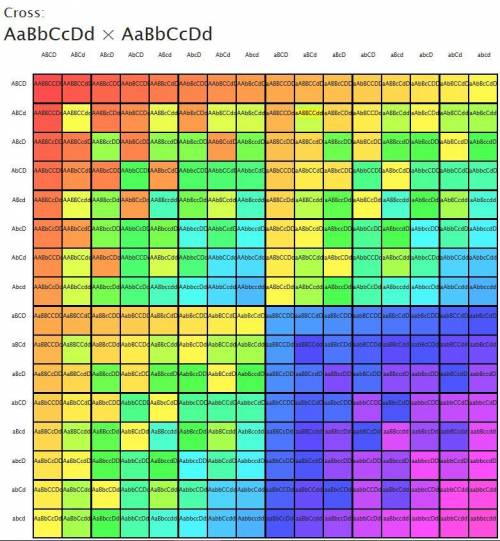
The genotype of f1 individuals in a tetrahybrid cross is aabbccdd. assuming independent assortment of these four genes, what are the probabilities that f2 offspring will have the following genotypes?
(a) aabbccdd
(b) aabbccdd
(c) aabbccdd
(d) aabbccdd
(e) aabbccdd

Answers: 1
Other questions on the subject: Biology


Biology, 22.06.2019 02:00, aredding7016
The accompanying figure shows the percent of selected dna sequences that match between a chimpanzee and other primates. these data support the hypothesis that the figure shows the percentage of selected d n a sequences that match between the chimpanzee and other primates. the human has an almost 98 percent match, the gorilla has an almost 97 percent match, the orangutan has a 96 percent match, the gibbon has an almost 95 percent match, and the old world monkey has an almost 92 percent match. the accompanying figure shows the percent of selected dna sequences that match between a chimpanzee and other primates. these data support the hypothesis that the figure shows the percentage of selected d n a sequences that match between the chimpanzee and other primates. the human has an almost 98 percent match, the gorilla has an almost 97 percent match, the orangutan has a 96 percent match, the gibbon has an almost 95 percent match, and the old world monkey has an almost 92 percent match. chimpanzees and gibbons are the most closely related the chimpanzee's closest surviving relative is humans orangutans are the primates least closely related to chimpanzees old world monkeys and gibbons are the most closely related
Answers: 1

Biology, 22.06.2019 08:30, wrightstephanie193
Which macromolecule catalyzes chemical reactions this be considered enzyme chemical reactions thus he considering enzymes
Answers: 1

Biology, 22.06.2019 09:10, ballin4534
Refer to this portion of a dichotomous key for fish identification to answer the question. 1. (a) has a single dorsal fin ® 5 (b) has a double dorsal fin ® 2 2. (a) one fin is spiny, the other is smooth ® 3 (b) one fin is not spiny or smooth ® 4 5. (a) has small fin on back near tail ® 6 (b) has no fin on back near tail ® 7 6. (a) has barbs near the mouth ® catfish (b) does not have barbs near the mouth ® 10 7. (a) tail is asymmetrical ® 8 (b) tail is symmetrical ® 9 10. (a) scales are small ® trout (b) scales are large ® whitefish what is the next step to complete to identify a fish that has a single dorsal fin, no fin on the back near the tail, and no barbs near the mouth? step 2 step 5 step 7 step 10
Answers: 2
Do you know the correct answer?
The genotype of f1 individuals in a tetrahybrid cross is aabbccdd. assuming independent assortment o...
Questions in other subjects:


Physics, 27.07.2019 07:00



History, 27.07.2019 07:00




Biology, 27.07.2019 07:00







